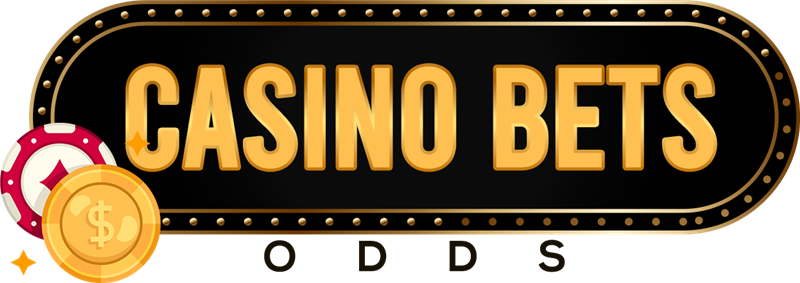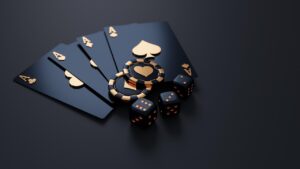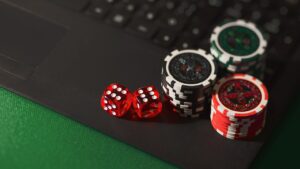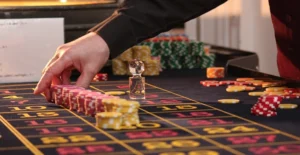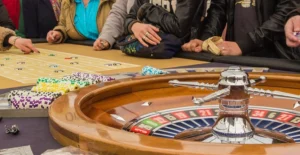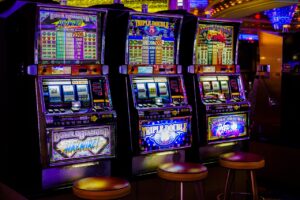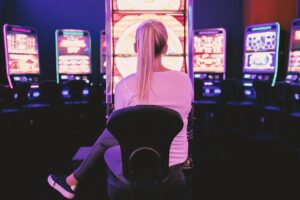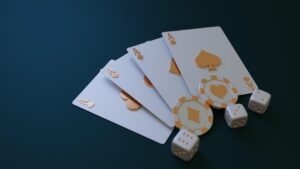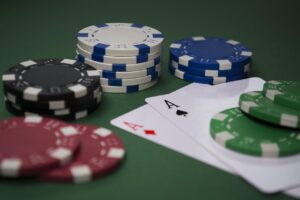Practicing blackjack on your own is a smart way to get better at the game. You can focus on the rules and strategies without any outside pressure. This guide will walk you through how to play blackjack by yourself, from setting up your game to improving your skills. It’s all about building confidence and making better decisions at the table.
Key Takeaways
- Playing blackjack alone allows for focused practice of basic strategy without distractions.
- Setting up a solo game involves understanding the rules and how to deal cards to yourself.
- Managing your bankroll and keeping track of wins/losses are important for solo practice.
- Utilizing strategy charts can help improve decision-making when playing by yourself.
- Common mistakes in solo play include not practicing enough or not sticking to strategy.
Introduction to Solo Blackjack: Understanding the Basics
Playing Blackjack by yourself might seem a bit unusual, but it’s a fantastic way to hone your skills without the pressure or distractions of a crowded table. Think of it as your personal training ground. You get to focus entirely on the game, making decisions based on the cards you see and the dealer’s upcard, all at your own pace. This solo approach lets you really internalize the strategies and understand the flow of the game. It’s a great way to build confidence before you hit the casino floor, or even just to enjoy a quiet game at home. The core idea is to treat yourself as both the player and the dealer, simulating real game conditions.
Why Play Blackjack Solo?
There are several good reasons to practice Blackjack on your own:
- Focused Learning: You can concentrate on understanding card values, hand rankings, and basic strategy without anyone else influencing your decisions or rushing you.
- Skill Refinement: It’s the perfect environment to practice card counting or test out different betting systems without risking real money or drawing attention.
- Convenience: You can play whenever you want, for as long as you want, without needing to coordinate with others or wait for a table to open.
What You’ll Need for Solo Blackjack
To get started with your solo Blackjack sessions, you’ll need a few things:
- A Deck of Cards: A standard 52-card deck is all you need. For more realistic practice, especially if you plan to learn card counting, using multiple decks (like four or six) is recommended. Make sure to remove the Jokers.
- A Playing Surface: A table or even just a clear, flat surface will do. If you want to get fancy, you can even get a felt mat that mimics a casino table.
- Something to Track Bets (Optional): If you want to practice bankroll management, you might want chips, coins, or even just a pen and paper to keep track of your wagers and your balance.
Practicing solo allows for uninterrupted focus on the game’s mechanics and strategic decision-making. This focused approach is key to developing a solid foundation in Blackjack.
What You Need to Play Blackjack Alone: Essential Equipment
To play blackjack by yourself, you’ll need a few key items to set up your personal gaming experience. Think of it as creating your mini-casino right at home.
Playing Cards
You’ll need a standard 52-card deck. For a more authentic feel and to practice with multiple decks as you might find in a casino, consider getting a shoe that holds multiple decks. This allows for a more realistic simulation, especially if you plan to practice card counting techniques. Many players prefer decks with a larger print for easier reading during extended play sessions. You can find blackjack card decks designed for gaming, which are often more durable than standard playing cards.
Blackjack Table or Surface
While a professional blackjack table is ideal, it’s not strictly necessary. A large, flat surface like a dining table or even a sturdy card table will work. Some players like to use a felt mat designed for card games, which helps cards slide smoothly and provides a designated playing area. This can also help protect your table surface.
Betting Chips or Tokens
To simulate betting and manage your bankroll, you’ll need chips. These can be actual casino-style chips, poker chips, or even different colored tokens or coins. Having a variety of denominations helps practice different bet sizes and manage your imaginary funds. The number of chips you need will depend on how much you want to simulate your starting bankroll.
Strategy Chart (Optional but Recommended)
While not a physical item you play with, a basic strategy chart is a vital tool for solo play. This chart provides the mathematically correct decision for every possible hand combination against the dealer’s upcard. Having this handy will help you learn and reinforce optimal play, reducing the house edge. You can easily find and print these online.
Pen and Paper or Score Sheet
To keep track of your wins, losses, and bankroll, a simple notepad and pen will suffice. Alternatively, you can find printable score sheets online. This helps you monitor your progress and identify patterns in your play.
Having the right equipment makes the practice sessions more engaging and realistic. It helps bridge the gap between theoretical knowledge and practical application, making your solo blackjack journey more effective.
Setting Up Your Blackjack Table for Solo Play
When you’re playing blackjack by yourself, setting up your table is pretty straightforward. You don’t need a fancy setup, just a clear space and the right tools. Think of it as your training ground for mastering the game.
Gathering Your Supplies
First things first, you’ll need a deck of cards. A standard 52-card deck is perfect, but if you plan on practicing card counting, using multiple decks (like four or six) shuffled together is a good idea. Make sure to remove the Jokers. Having a clean, flat surface is also important, whether that’s a dining table or a dedicated card table.
Creating Your Playing Area
Designate a spot for your ‘dealer’ position and your ‘player’ position. Since you’re playing alone, you’ll be both. Place the deck of cards within easy reach of your dealer’s hand. If you’re practicing betting, you might want to set aside a small area for your chips or betting markers.
Optional Additions for Practice
To get the feel of a casino game, consider using a felt mat or even just a piece of cardboard to mimic a blackjack table. This helps define your playing space and can make the experience feel a bit more authentic.
Practicing with a clear setup helps you focus on the decisions you need to make, rather than fumbling with your cards or chips. It’s all about building good habits.
Key Elements for Solo Play:
- Playing Cards: A standard 52-card deck, or multiple decks for advanced practice.
- Clear Surface: A table or flat area to lay out your cards and chips.
- Dealer/Player Area: Designate where the cards will be dealt from and where your hands will be played.
- Betting Area (Optional): A space for chips or markers if you’re practicing bankroll management.
- Felt Mat (Optional): For a more realistic feel and to keep cards from sliding.
Understanding the Rules of Blackjack: A Quick Overview
When you’re playing blackjack by yourself, it’s important to get a solid grasp on the rules. This isn’t just about knowing how to play; it’s about understanding the mechanics that govern every decision you’ll make. The core objective in blackjack is simple: beat the dealer’s hand without going over 21. Achieving a ‘blackjack,’ a two-card total of 21, is the best possible outcome.
The Objective of the Game
The primary goal is to have a hand total that is higher than the dealer’s hand total, without exceeding 21. If your hand exceeds 21, it’s called a ‘bust,’ and you automatically lose.
Card Values
- Number cards (2-10): Worth their face value.
- Face cards (Jack, Queen, King): Each is worth 10.
- Ace: Can be worth either 1 or 11, whichever is more beneficial to the hand.
Basic Gameplay Flow
- Place your bet.
- Receive two cards. You’ll get two cards, usually face up. The dealer also gets two cards, one face up (the ‘upcard’) and one face down (the ‘hole card’).
- Player’s turn. You decide how to play your hand based on your cards and the dealer’s upcard.
- Dealer’s turn. After all players have finished their turns, the dealer reveals their hole card and plays their hand according to fixed rules.
Player Actions
- Hit: Take another card.
- Stand: Take no more cards.
- Double Down: Double your initial bet and receive only one more card.
- Split: If your first two cards are a pair, you can split them into two separate hands, placing an additional bet equal to your original bet.
Dealer Rules
Dealers must follow strict rules. Typically, they must hit until their hand totals 17 or more. Some tables have specific rules about hitting on a ‘soft 17’ (an Ace and a 6).
Payouts
A standard win pays 1:1. A ‘blackjack’ (a natural 21 on the first two cards) usually pays 3:2, though some games offer a less favorable 6:5 payout. If you and the dealer tie, it’s a ‘push,’ and your bet is returned.
When learning blackjack rules, pay close attention to the specific payout for a natural blackjack. A 3:2 payout is significantly better for the player than a 6:5 payout, and it’s worth seeking out games that offer the better rate. This single rule change can impact the house edge considerably.
Understanding these basics is the first step toward playing blackjack effectively, even when you’re playing by yourself. It’s all about making informed decisions based on the cards you see and the dealer’s upcard. For a more detailed strategy, consider looking into Blackjack Early Payout options.
How to Deal Cards in Solo Blackjack: Step-by-Step Guide
Dealing cards by yourself in blackjack is straightforward, but getting the process right is key to practicing effectively. You’ll want to mimic the casino experience as closely as possible to make your solo sessions truly beneficial.
Preparing Your Deck
First things first, gather your cards. For solo practice, it’s best to use multiple decks, just like in a casino. Combining four standard decks, with Jokers removed, is a good starting point. If you can, use cards that have identical backs to make the dealing process feel more authentic. This setup helps simulate the real game environment, especially when you’re trying to get a feel for how many decks are used.
The Dealing Process
- Shuffle Thoroughly: Give your decks a good shuffle. The more you shuffle, the more random the card distribution will be, mirroring a fresh shoe in a casino.
- Deal the Player’s Hand: Place one card face up in front of you, representing your first player hand. Then, deal one card face down to the dealer’s position. This face-down card is the dealer’s “hole card.”
- Deal the Second Round: Deal another card face up to your player’s hand. Then, deal a second card face up to the dealer. This second face-up card is the dealer’s “up-card.”
- Dealer’s Peek (Optional but Recommended): In a real casino, if the dealer’s up-card is an Ace or a 10-value card, they will check their hole card for a blackjack. If they have one, they reveal it, and the hand ends. For solo practice, you can simulate this. If you’re playing multiple hands, you might even deal all dealer cards face up to speed things up, as the core practice is about your decisions, not hiding information from yourself.
When practicing, remember that the goal is to internalize the correct decisions. Don’t get too caught up in the “mystery” of the hole card if it hinders your practice. You can adjust the simulation to best suit your learning needs.
Simulating Multiple Hands
To really get the most out of solo play, try simulating multiple player hands. Deal two or even three hands to yourself, placing separate bets on each. Play out each hand according to blackjack rules, making decisions for each one independently. This helps you practice managing different scenarios simultaneously, much like you would at a crowded table. It’s a great way to build your blackjack decision-making skills.
Basic Blackjack Strategies for Solo Players
When you’re playing blackjack by yourself, focusing on basic strategy is key to improving your game. This solo blackjack strategy isn’t about complex card counting yet, but rather about making the mathematically correct decision for every hand you’re dealt. It’s about building a solid foundation for your blackjack practice alone.
Start with Simple Hit/Stand Decisions
Forget splitting, doubling, and surrendering for now. Focus on hit/stand decisions for hard and soft player hands. While you wouldn’t want to play blackjack without those more advanced moves at your disposal, you can blend these simpler choices into your practice. The goal here is to internalize the correct play for each hand combination against the dealer’s upcard. This is the most fundamental aspect of blackjack for single players.
Practice with Basic Strategy Charts
Using a basic strategy chart is highly recommended when you’re starting. These charts lay out the optimal play for every possible hand combination. Keep one handy as you deal cards to yourself. After each hand, check the chart to see if your decision matched the recommended play. This immediate feedback loop is incredibly effective for learning.
Simulate Realistic Scenarios
To make your blackjack practice more effective, try to simulate real game conditions. This means dealing yourself multiple hands, just as you would if you were at a casino table. Play out each hand according to basic strategy. This helps you get a feel for the flow of the game and how decisions impact multiple outcomes. You can even try incorporating an imaginary bankroll to practice betting.
Focus on Key Decisions
As you get more comfortable, you can start to focus on specific decision types. For instance, dedicate a session to just practicing your doubling-down decisions or your splitting decisions. This targeted approach can help you master the trickier aspects of solo blackjack strategy. Remember, consistent practice is what turns good intentions into solid gameplay.
The core of effective solo blackjack play lies in consistent, focused practice. By breaking down the game into manageable steps and utilizing available resources like strategy charts, you can significantly improve your decision-making skills without the pressure of a live table.
Card Values and Hand Rankings in Blackjack
Understanding the value of each card is pretty straightforward in Blackjack, but knowing how they combine to form winning hands is where the game gets interesting. You’re aiming to get as close to 21 as possible without going over, and the dealer is doing the same. It’s a bit of a dance between you, the dealer, and that magic number.
Card Values
Most cards are worth their face value. So, a 2 is worth 2 points, a 7 is worth 7 points, and so on, up to a 10, which is worth 10 points. The picture cards – the King, Queen, and Jack – are also all worth 10 points each. The Ace is a bit special; it can be worth either 1 point or 11 points. You get to decide which value is best for your hand at any given moment.
| Card | Value(s) |
| 2 through 10 | Face Value |
| Jack, Queen, King | 10 |
| Ace | 1 or 11 |
Hand Rankings and Blackjack
The goal is to beat the dealer’s hand without exceeding 21. If your total goes over 21, it’s called a ‘bust,’ and you automatically lose your bet. The best possible hand is a ‘Blackjack,’ which is an Ace and a 10-value card (10, Jack, Queen, or King) dealt as your first two cards. This gives you a total of 21. A Blackjack typically pays out at a higher rate, often 3 to 2, compared to a regular win, which pays 1 to 1.
Here’s a quick rundown of how hands are valued:
- Number Cards (2-10): Worth their printed value.
- Face Cards (Jack, Queen, King): Each is worth 10 points.
- Ace: Can be counted as either 1 or 11 points. You’ll use the value that benefits your hand the most without busting.
When you have an Ace, you always want to count it as 11 if it doesn’t cause your hand total to exceed 21. If counting it as 11 would make you bust, then you count it as 1 instead. This flexibility is key to making good decisions.
Knowing these values is the first step to playing the game effectively. It helps you decide whether to hit (take another card) or stand (keep your current hand). For a more detailed look at how to play, check out this guide to playing blackjack.
How to Manage Your Bankroll While Playing Alone
When you’re playing blackjack by yourself, managing your money is just as important as knowing the rules. It’s not just about having enough cash to play; it’s about making sure you can play for a decent amount of time and not run out of funds too quickly. Think of your bankroll as your playing fuel.
Setting Your Solo Bankroll
Before you even deal the first card, decide how much money you’re willing to risk for your solo session. This amount should be money you can afford to lose without it impacting your daily life. It’s a good idea to break this total amount down into smaller, manageable units, often called betting units. A common approach is to set your betting unit at 1% to 2% of your total bankroll. For example, if you have $500 set aside for playing, a $5 to $10 bet would be a reasonable unit.
Bet Sizing for Solo Play
Your bet size should generally stay consistent, especially when you’re just practicing or playing for fun. Avoid making drastic changes to your bet size based on whether you just won or lost a hand. While some advanced players might adjust bets based on card counting, for solo practice, sticking to a flat bet or a very controlled progression is best. This helps you get a feel for the game’s natural ups and downs without risking too much on any single hand.
Here’s a simple way to think about bet sizing:
- Minimum Bet: Always know the table’s minimum bet. Your betting unit should ideally be at least this amount.
- Maximum Bet: While you might be tempted to bet big after a win, try to keep your bets within a reasonable range, perhaps no more than 5-10 times your minimum betting unit.
- Consistency: The goal is to make your bankroll last. Consistent betting helps achieve this.
Tracking Your Wins and Losses
It’s easy to lose track of how much you’re up or down when playing alone. Keep a simple record, either on paper or using a notes app on your phone. Note down your starting bankroll, the amount you bet on each hand (or at least your average bet), and your ending bankroll. This practice helps you see your progress and understand how your betting strategy affects your overall results. It also helps you stick to your predetermined session limits.
Managing your money effectively is a skill that separates casual players from those who can enjoy the game long-term. It’s about discipline and making smart choices, even when no one else is watching.
Playing Multiple Hands
If you decide to play multiple hands at once, which is a great way to practice, remember that your total bet per round increases. If you’re betting $10 on one hand, and you decide to play three hands, you’re now betting $30 per round. Make sure your bankroll can support this increased action. You might need to adjust your betting unit size or play fewer hands if your bankroll is limited. This is a good way to test your bankroll management skills under slightly more pressure.
Session Limits
Set limits not just for how much you can spend, but also for how long you’ll play. A common approach is to set a time limit, like playing for one hour, or until you’ve lost a certain percentage of your session bankroll (e.g., 25%). This prevents you from getting too caught up in the game and potentially losing more than you intended. It’s all part of playing responsibly, even when you’re your opponent.
Common Mistakes to Avoid in Solo Blackjack
Playing blackjack by yourself can be a great way to hone your skills, but it’s easy to fall into some common traps. Being aware of these pitfalls can help you practice more effectively and avoid costly errors when you eventually play at a real table.
Ignoring Basic Strategy
Even when playing alone, sticking to basic strategy is important. It’s tempting to deviate when there’s no one else to influence your decisions, but this is precisely when you should be reinforcing good habits. Treat every hand as if you were in a real casino environment.
Not Practicing Bankroll Management
Solo play is the perfect time to get a feel for managing your money. If you’re not simulating bets and tracking your wins and losses, you’re missing a big part of the learning process. Use chips or a simple ledger to keep track of your imaginary bankroll.
Playing Too Fast or Too Slow
Without the natural pace of a multi-player game, you might find yourself rushing decisions or taking too long. Try to establish a consistent rhythm that mimics a real game. This helps build stamina and decision-making speed.
Failing to Simulate Realistic Scenarios
Simply playing hand after hand without any variation isn’t very helpful. Try simulating different table conditions, like playing multiple hands at once or practicing card counting techniques like the Hi-Lo strategy.
Over-Reliance on Strategy Charts
While strategy charts are useful, the goal of solo play is to internalize these decisions. If you’re constantly referring to a chart, you’re not truly practicing. Aim to reduce your reliance on them as you become more comfortable.
It’s easy to get complacent when you’re the only one at the table. Remember that the objective is to prepare for real-game situations, not just to pass the time.
Using Blackjack Strategy Charts for Better Decision Making
Using a blackjack strategy chart is like having a map for your game. It tells you the mathematically best move to make in any given situation, based on your hand and the dealer’s up card. These charts are built on millions of simulated hands and are designed to minimize the house edge. While playing alone, you can use these charts to build solid habits without the pressure of a live table.
Understanding Basic Strategy Charts
Blackjack strategy charts are typically broken down into three main sections: Hard Totals, Soft Totals, and Pairs. Each section shows your hand on one axis and the dealer’s up card on the other. The intersection tells you whether to Hit, Stand, Double Down, Split, or Surrender (if applicable).
- Hard Totals: These are hands that do not contain an Ace, or hands where an Ace must be counted as ‘1’ to avoid busting.
- Soft Totals: These are hands that contain an Ace, which can be counted as either ‘1’ or ’11’ without busting.
- Pairs: These are hands where you have two cards of the same rank, offering the option to split them into two separate hands.
Practicing with Strategy Charts
When you’re playing by yourself, you can take your time to learn these charts. Start with the ‘Hard Totals’ section. Deal yourself a hand and look at the dealer’s up card. Find the corresponding move on the chart and make it. Then, deal yourself another hand and repeat. Try to do this without looking at the chart too much. The goal is to get to a point where you know the correct play without needing to check.
Practicing with a strategy chart solo helps ingrain the correct decisions into your memory. This makes it much easier to recall them when you’re playing in a real casino or online, even if you’re a bit nervous.
Progressing to More Complex Decisions
Once you’re comfortable with the basic hit and stand decisions, you can move on to the more complex parts of the chart, like when to double down or split pairs. For example, if you have a hard 11, the chart will tell you when to double down against different dealer up cards. Similarly, it will guide you on when to split pairs like Aces or Eights. You can simulate these scenarios repeatedly. For instance, practice doubling down on all your hard 11s against every possible dealer up card. Then, move on to practicing your pair splits. This focused practice helps solidify your understanding of these key blackjack strategy charts.
How to Keep Track of Your Wins and Losses
Keeping track of your wins and losses when playing blackjack by yourself is a smart move. It helps you understand your performance and manage your money better. Think of it like keeping score in any game; it gives you a clear picture of how you’re doing over time.
Session Tracking
For each playing session, it’s a good idea to note down your starting bankroll, how much you bet, and your ending bankroll. This gives you a snapshot of your results for that particular day or time you sat down to play. You can use a simple notebook or a spreadsheet for this.
Here’s a basic way to log your sessions:
- Date: When you played.
- Starting Bankroll: The amount of money you began with.
- Total Bets Placed: The sum of all your wagers during the session.
- Total Winnings: The amount you won.
- Total Losses: The amount you lost.
- Ending Bankroll: The amount of money you finished with.
- Net Result: Ending Bankroll minus Starting Bankroll.
Long-Term Record Keeping
Beyond individual sessions, maintaining a long-term record is even more beneficial. This allows you to spot trends in your play and identify if your strategies are working. A consistent record helps you make informed decisions about your bankroll management.
Consider these elements for your long-term tracking:
- Overall Profit/Loss: The total difference between your starting bankroll and your current bankroll across all sessions.
- Win Rate: The percentage of hands or sessions you won.
- Average Bet Size: Your typical wager amount.
- Performance by Strategy: If you experiment with different strategies, track which ones yield better results.
Keeping detailed records isn’t just about numbers; it’s about self-awareness as a player. It helps you understand your emotional responses to winning and losing streaks, which is a big part of playing blackjack responsibly.
Tracking your results can also help you stick to your bankroll management plan. If you see yourself consistently losing more than you win, it might be time to adjust your betting strategy or take a break. This kind of self-monitoring is what separates casual players from those who approach the game with more discipline. Remember, even when playing alone, treating it like a serious game with proper record-keeping can make it more rewarding and help you improve your skills, much like understanding your position at the table in poker, where knowing if you’re in a favorable spot can influence your decisions.
Advanced Techniques for Solo Blackjack Players
Once you’ve got the basics down, it’s time to sharpen your blackjack skills. This means moving beyond just playing your hand and thinking about how to get the most out of your practice time. One effective way to improve your blackjack skills is by practicing card counting, even if you don’t plan to use it in a casino. It helps you understand the flow of the game and how the deck composition changes.
Counting Practice
Card counting requires consistent practice. The math itself isn’t overly complex, but blackjack games can move quickly, and it’s easy to lose track. Unlike basic strategy, you can’t use aids at the table. The only way to become proficient is through dedicated home practice until you can tally card values and maintain a running count without thinking too hard.
Flip Drill
This drill is straightforward. Similar to your solo blackjack game, you’ll want to use multiple decks to practice counting. Turn the cards over one by one and maintain a running count. Start slowly, flipping cards individually and keeping track of the count. Then, do a quick review of the dealt cards to check your accuracy.
Simulate a Game
Run through a full mock game, but this time, simulate four or five player hands. In addition to keeping the running count, see how well you can make the correct basic strategy decisions. This helps you practice how to win at blackjack without counting cards, focusing on optimal play.
Playing Multiple Hands
Some casinos permit solo players to occupy multiple seats at a single blackjack table if space allows. Ask the dealer if you can bet on multiple hands. The game proceeds as you’d expect – place your bets and play out each hand individually. In single-deck games, cards are often dealt face down, and you’ll need to play out your first hand before looking at others. If your bankroll supports it, playing multiple spots solo in a casino can be a great way to practice decision-making and counting. Try visiting casinos during off-peak hours, like mornings or early afternoons, to find tables with available seats.
Remember that consistent practice is key. Don’t get discouraged if you don’t see results immediately. Keep at it, and your blackjack skills will improve.
Frequently Asked Questions
What does it mean to play Blackjack by yourself?
Playing Blackjack by yourself means you act as both the player and the dealer. This allows you to focus entirely on making the best decisions without distractions from other players or the dealer’s actions, helping you master basic strategy.
What do I need to play Blackjack alone?
To play alone, you’ll need a standard deck of cards (or multiple decks), a clear space to set up your “table,” and perhaps some chips or a way to track your bets and wins. You’ll deal the cards to yourself, making decisions for both the player and the dealer.
How should I set up my table for solo Blackjack?
You can set up your solo Blackjack table anywhere comfortable. Designate a spot for the dealer’s cards and another for your player hand. Keep your betting area clear. The goal is to create a space that mimics a real Blackjack table setup.
Can you briefly explain the rules of Blackjack?
The main goal is to get a hand total closer to 21 than the dealer, without going over 21. You receive two cards, and the dealer receives two (one face up, one face down). You can ‘hit’ (take another card) or ‘stand’ (keep your current hand).
How do I deal the cards when playing Blackjack by myself?
In solo play, you deal the cards to yourself. First, deal two cards to the ‘player’ (yourself) and two to the ‘dealer’ (yourself). Remember to keep one dealer card hidden. Then, make your player decisions based on the rules and your strategy.
What are some basic strategies for solo Blackjack players?
Basic strategy involves knowing when to hit, stand, double down, or split based on your hand and the dealer’s visible card. Committing this strategy to memory is key to reducing the house’s advantage.
What are the card values in Blackjack?
Number cards are worth their face value. Face cards (Jack, Queen, King) are worth 10. Aces can be worth 1 or 11. The goal is to get as close to 21 as possible without exceeding it.
How can I manage my money when playing Blackjack alone?
When practicing alone, it’s helpful to set a virtual bankroll. Decide on a starting amount and track your wins and losses. This helps you practice betting strategies and manage your money responsibly, even without real cash.
Daniel Chase is a seasoned casino analyst and iGaming writer with over 10 years of experience in the online gambling industry. He specializes in game strategy, casino odds, and player-focused reviews. Daniel is passionate about helping players make smarter decisions through transparency, real data, and honest insight.
